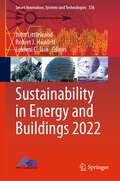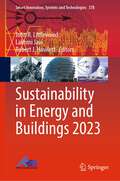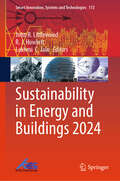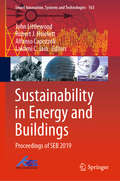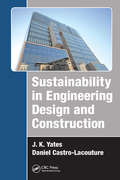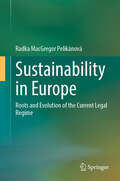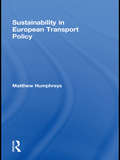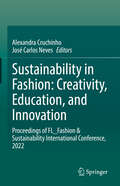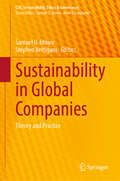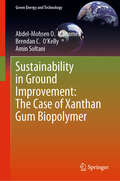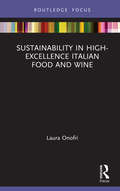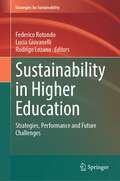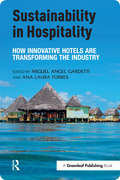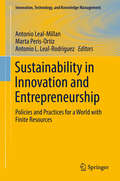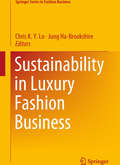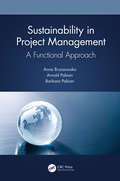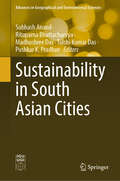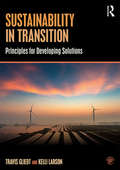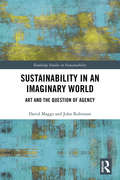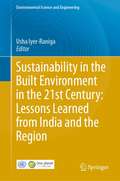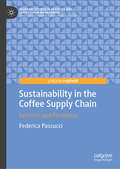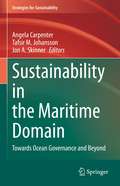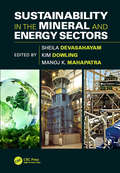- Table View
- List View
Sustainability in Energy and Buildings 2022 (Smart Innovation, Systems and Technologies #336)
by Lakhmi C. Jain Robert J. Howlett John LittlewoodThis book contains the proceedings of the 14th KES International Conference on Sustainability and Energy in Buildings 2021 (SEB2022) held in Split, Croatia, during September 14–16, 2022, organized by KES International. SEB22 invited contributions on a range of topics related to sustainable buildings and explored innovative themes regarding sustainable energy systems. The conference formed an exciting chance to present, interact and learn about the latest research and practical developments on the subject. The conference attracted submissions from around the world. Submissions for the full-paper track were subjected to a blind peer-reviewed process. Only the best of these were selected for presentation at the conference and publication in these proceedings. It is intended that this book provides a useful and informative snapshot of recent research developments in the important and vibrant area of sustainability in energy and buildings.
Sustainability in Energy and Buildings 2023 (Smart Innovation, Systems and Technologies #378)
by Robert J. Howlett John R. Littlewood Lakhmi JainThis book contains the proceedings of the 15th KES International Conference on Sustainability and Energy in Buildings 2023 (SEB2023) held in Bari, Italy, during September 18–20, 2023, organized by KES International. SEB23 invited contributions on a range of topics related to sustainable buildings and explored innovative themes regarding sustainable energy systems. The conference formed an exciting chance to present, interact, and learn about the latest research and practical developments on the subject. The conference attracted submissions from around the world. Submissions for the full-paper track were subjected to a blind peer-reviewed process. Only the best of these were selected for presentation at the conference and publication in these proceedings. It is intended that this book provides a useful and informative snapshot of recent research developments in the important and vibrant area of sustainability in energy and buildings.
Sustainability in Energy and Buildings 2024 (Smart Innovation, Systems and Technologies #113)
by Lakhmi C. Jain John R. Littlewood R. J. HowlettThis book contains the proceedings of the 16th KES International Conference on Sustainability and Energy in Buildings 2024 (SEB2024) held in Madeira, Portugal, during September 18–20, 2024, organized by KES International. SEB24 invited contributions on a range of topics related to sustainable buildings and explored innovative themes regarding sustainable energy systems. The conference formed an exciting chance to present, interact, and learn about the latest research and practical developments on the subject. The conference attracted submissions from around the world. Submissions for the full-paper track were subjected to a blind peer-reviewed process. Only the best of these were selected for presentation at the conference and publication in these proceedings. It is intended that this book provides a useful and informative snapshot of recent research developments in the important and vibrant area of sustainability in energy and buildings.
Sustainability in Energy and Buildings: Proceedings of SEB 2019 (Smart Innovation, Systems and Technologies #163)
by Lakhmi C. Jain Robert J. Howlett John Littlewood Alfonso CapozzoliThis volume contains the proceedings of the 11th KES International Conference on Sustainability and Energy in Buildings 2019 (SEB19) held in Budapest, 4th -5th July 2019 organised by KES International in partnership with Cardiff Metropolitan University, Wales, UK. SEB-19 invited contributions on a range of topics related to sustainable buildings and explored innovative themes regarding sustainable energy systems. The aim of the conference was to bring together researchers, and government and industry professionals to discuss the future of energy in buildings, neighbourhoods and cities from a theoretical, practical, implementation and simulation perspective. The conference formed an exciting chance to present, interact, and learn about the latest research and practical developments on the subject. The conference attracted submissions from around the world. Submissions for the Full-Paper Track were subjected to a blind peer-review process. Only the best of these were selected for presentation at the conference and publication in these proceedings. It is intended that this volume provides a useful and informative snapshot of recent research developments in the important and vibrant area of Sustainability in Energy and Buildings.
Sustainability in Engineering Design and Construction
by J. K. Yates Daniel Castro-LacoutureSuccessfully Measure the Benefits of Green Design and Construction Sustainability in Engineering Design and Construction outlines the sustainable practices used in engineering design and construction operations for all types of engineering and construction projects. Aimed at ushering the engineering and construction industry into embracing sustainable practices and green construction techniques, this book addresses sustainability in engineering design and construction operations from a historical and global perspective, and delves into specific sustainability concepts and processes. The book explains the concepts of sustainable development, corporate social responsibility (CSR), the Dow Jones Global Sustainability Index (DJGSI), key performance indicators (KPIs), corporate sustainability, and the triple bottom line (economic, environmental, and social values in design and construction). Relevant to sustainability in every facet of engineering and construction, it also covers life-cycle environmental cost analysis, discusses sustainable engineering and site selection, the economic considerations evaluated when making sustainability decisions, and explains how to measure and quantify sustainable performance and apply these practices in the real world. It also covers project and corporate level sustainability practices, sustainable construction materials and processes, sustainable heavy construction equipment, traditional and alternative energy sources, provides implementation resources for starting and evaluating sustainability programs, and includes a checklist for measuring the sustainability of construction operations. The text contains detailed information on sustainable construction materials and processes, heavy construction equipment, and traditional and alternative energy sources. It presents information on sustainable designs, selecting sustainable sites, designing for passive survivability, designing for disassembly, and the ISO 14,000 standards. It provides implementation resources for starting and evaluating sustainability programs and a checklist for measuring the sustainability of construction operations In addition, it provides definitions of sustainability terms and expressions, as well as case studies, examples, discussion questions, and a list of supplemental references at the end of each chapter. This book provides information on: Definitions for sustainability terms Sources for locating global sustainability requirements Current sustainability issues Environmental laws related to sustainability and their implications Sustainable design Life-cycle cost assessment models Sustainable practices currently being used in the engineering and construction (E&C) industry Corporate-level sustainability practices Project-level sustainability practices Global sustainability trends and implications Sustainable materials Sustainable heavy construction equipment Traditional and alternative energy sources LEED Green Building Rating System Sustainability organizations and certification programs Sustainability implementation resources A summary of sustainable engineering design and construction
Sustainability in Europe: Roots and Evolution of the Current Legal Regime
by Radka MacGregor PelikánováThis book analyses the roots and evolution of the concept of sustainability in Europe and the European Union. As sustainability has always mirrored certain value judgments on justice and priorities, it is suitable for functionalist, analytical, contextual and historical comparisons via multidisciplinary studies combining various branches of the social sciences, law, philosophy, and economics. The aim of this book is to explore the roots and evolution of sustainability, so as to reveal how a European style of sustainability has emerged, one that is inextricably linked to our civilization and history. It identifies linear and cyclical phases with clear trends toward expanding the reach of sustainability, its subjects and their duties. The book offers a multidisciplinary, chronological and contextual overview of the evolution of sustainability until the 21st century, while also addressing its legal regime. Sustainability has many faces and needs to be approached in a dynamic manner through the lens of sustainable development or via a multi-stakeholder model that includes private subjects and corporate social responsibility. Although primarily intended for an audience with an advanced background in law, economics and philosophy, the book will also benefit a more general audience, particularly those who want to learn where the current sustainability concerns and legal regime actually came from.
Sustainability in European Transport Policy
by Matthew HumphreysThe construction of the European Economic Communities in 1950 primarily set out to build an integrated economic zone in which national borders were, to a large extent, overcome. The ability of persons and goods to move freely within the economic zone was seminal in the realisation of economic integration. Underlying this, and therefore an implied necessity for European growth, an effective transport infrastructure was essential. However, with rising awareness of environmental issues, and a closer regard to sustainability of development, European transport systems and their regulation have come under scrutiny. This book sets out a critical analysis of the body of law and policy initiatives that constitute the EU's common transport policy. The development of the transport policy is charted through amending and founding Treaties as well as non-legislative documents. The book uses a model of sustainability as the basis for the analysis as the criteria for sustainable development were set out under Article Eleven of the Treaty on the Functioning of the European Union. However, sustainable development, when taken in the context of transport is difficult to reconcile with unbridled economic growth and unchecked freedom of movement and the book identifies a contradiction at the heart of European policy which can only become more accentuated as environmental trends become more explicit. The book argues that European regulation will eventually be forced to recognize this dichotomy, and take more forceful action to protect environmental and social development, even at the cost of economic progress. This book will be of great interest to researchers and students on European Union law and policy courses, transport studies courses and European integration courses. The book is of relevance to all those interested in environmental and transport matters.
Sustainability in Fashion: Proceedings of FL_Fashion & Sustainability International Conference, 2022
by Alexandra Cruchinho José Carlos NevesSustainability in Fashion: Creativity, Education, and Innovation is a book that focuses on how sustainability can be integrated into the fashion and clothing industry. The set of chapters provides peer-reviewed research covering a wide range of topics, mainly focused on how sustainability can be incorporated into fashion and textile education, how consumer behaviour and marketing affect sustainability in fashion (and vice versa) and how circular economy principles can be incorporated into clothing and textile supply chains. The chapters in this proceedings volume examine sustainability not only from the perspective of academia, but also from the perspective of industry. Working across sectors in this manner can facilitate the development of real projects that can greatly contribute to sustainability in the fashion industry.
Sustainability in Global Companies: Theory and Practice (CSR, Sustainability, Ethics & Governance)
by Samuel O. Idowu Stephen VertigansThis textbook focuses on how sustainability is practiced in companies in different sectors of the global economy - examples include aviation, banking, energy, financial services, food, manufacturing, technology, transportation, and tourism. These corporate sectors are at the forefront of the debate around business and sustainability both in their usage of finite resources and their potential to deliver meaningful solutions. Consequently, several experts were brought together for this book and asked to focus on how sustainability is understood and practiced in different companies around the globe in terms of the UN Sustainable Development Goals 2030. Chapters incorporate theoretical and applied examples that can help improve levels of insight into international business approaches. They provide opportunities to learn and disseminate factors that are delivering short, medium, and long-term solutions and problems. These insights can incorporate the spectrum of activities required inorder to achieve sustainability through industrial processes, supply chains to consumer behavior. The multi-disciplinary nature of the fundamental issues also prompted a diverse selection of academics and practitioners across disciplines who have knowledge and/or experiences of sustainability and international business theories, practices, and processes. Students and academics from across related disciplines, corporations, policymakers, and members of societies who study or have an interest in sustainable development will particularly find this book useful.
Sustainability in Ground Improvement: The Case of Xanthan Gum Biopolymer (Green Energy and Technology)
by Abdel-Mohsen O. Mohamed Brendan C. O’Kelly Amin SoltaniSustainable soil stabilization solutions aim to maintain a perfect balance between infrastructure performance and the social, economic and ecological processes required to sustain human equity, diversity, and the functionality of natural systems. To this end, biopolymers, either chemically synthesized from biological matter or biosynthesized by living organisms, are exhibiting great promise as a financially competitive and green alternative for conventional calcium-based binders. Recent experimental studies have shown that soils stabilized by polysaccharide-type biopolymers, such as xanthan gum (XG), exhibit a variety of promising physical and mechanical treatments, including improved water-retention capacity, reduced compressibility and hydraulic conductivity, enhanced shear strength, and improved resistance against wind/water erosion. Despite these advancements, the existing literature reveals numerous inconsistencies, and a thorough understanding of the behaviour/properties of XG-treated soils under diverse loading and environmental conditions remains somewhat elusive. More importantly, there remains a notable gap in understanding how different factors affect the interactions between XG and various soil types throughout the processes of mixing, curing, and later environmental exposure. This book represents the first of its kind, offering a comprehensive, fundamental overview of the current state of XG usage for sustainable ground improvement, while also identifying future research directions towards addressing existing gaps in knowledge and application.
Sustainability in High-Excellence Italian Food and Wine (Routledge Focus on Environment and Sustainability)
by Laura OnofriThis book presents contemporary case studies on selected Italian food and wine products to explore how traditional production and consumption models address and adapt to the sustainability challenges in the Italian high-excellence agri-food sector. Sustainability in High-Excellence Italian Food and Wine adopts a transaction cost economics approach, which is applied to five case-study chapters, each focusing on a key Italian agri-food product: Parmigiano Reggiano, Mozzarella di Bufala Campana, Amarone wine, Prosecco wine, and Prosciutto di San Daniele. The production and organization of these products face many challenges as they seek to balance competing priorities around economic viability, maintenance of high-quality standards and environmental and social impacts. The book argues that the development of sustainable and quality models requires changes to the structure and organization of the supply chain while also acknowledging that consumers are increasingly demanding authentic, high-excellence products that require reliable labeling systems and designations of origin mechanism. Recommending that hybrid structures, such as cooperatives and consortia, are the most cost-minimizing governance structures for the production, the book highlights that in the case of Italian excellency food, environmental sustainability and economic efficiency are not actually traded off but are reciprocally valorized through the regulation of high-quality standards. This book will be of great interest to students and scholars of food and wine excellence products, food systems and supply chains, agricultural production and economics and sustainable consumption.
Sustainability in Higher Education: Strategies, Performance and Future Challenges (Strategies for Sustainability)
by Rodrigo Lozano Federico Rotondo Lucia GiovanelliThis contributed volume addresses the issue of how higher education institutions can systematically reorient themselves to help society become more sustainable. In particular, a strategic management approach is used to overcome the fragmentation of sustainability initiatives increasingly conducted by higher education institutions worldwide. In this book, eminent scholars in the field of sustainability in higher education combine their different backgrounds to propose conceptual frameworks for interpreting and measuring sustainability integration in higher education institutions. The chapters contained herein explore which processes and management tools should be used, as well the challenges to be faced, to make sustainable innovation effective. The cases present in this volume offer a guide for higher education institution management to lead the sustainability transition.
Sustainability in Hospitality: How Innovative Hotels are Transforming the Industry
by Miguel Angel Gardetti Ana Laura TorresThis ground-breaking research represents the most complete collection yet on how the hospitality industry is addressing sustainability and ethical issues. Covering supply chain management, innovative sustainability initiatives, CSR programmes, biologically-respectful tourism and Value Creation, Sustainability in Hospitality: How Innovative Hotels are Transforming the Industry presents valuable global viewpoints on embedding sustainability into all aspects of the hospitality industry, and the impact this could have on transforming the sector into an advocate for more sustainable, eco-conscious tourism.The chapters in this edited collection span organizational governance, human rights and labour practices, environment and climate change, fair operating practices, stakeholder engagement, CSR and strategic management. The global reach of the collection brings case studies from China, the US, the UK, Mexico and Italy, while company case studies include Fairmont Luxury Hotels and Sextantio.Sustainability in Hospitality: How Innovative Hotels are Transforming the Industry will be an essential read for academics researching the development of ethically-conscious and sustainable hospitality, and for hotel managers and group CEOs who want to know how sustainability and CSR can be embedded in their day-to-day operations.
Sustainability in Innovation and Entrepreneurship
by Marta Peris-Ortiz Antonio Leal-Millan Antonio L. Leal-RodríguezThis book provides a richly illustrated study of sustainability, innovation and entrepreneurship. Specifically, it examines the ways in which governmental policies and practices modify the social conditions necessary to promote innovation in businesses and by so doing impact economic development. Exploring topics such as green innovation, green customer capital, smart cities, green entrepreneurship and environmental responsibility, this book presents some of the most current research and best practices in the field. In today's global economy, strategies, policies and practices that address the negative effects of human activity on the environment need to be incorporated into the business framework in order for companies to achieve a sustainable competitive advantage. Around the world, such changes have already resulted in a broad range of products, production methods and technical features that ensure environmental protection. At the same time, the mass media's communication of a deteriorating earth have motivated a growing number of citizens in both developed and developing nations to modify their consumption habits towards more ecological products. Consequently, an increasing number of companies are reacting to these changes in business and legal frameworks and consumer preferences by investing in new forms of green innovation or "eco-innovation" designed to promote both environmental and corporate sustainability. For example, Hewlett-Packard eliminated lead from its welding process; Wal-Mart reduced the emissions of their suppliers; and Cisco, Dell and IBM are investing in smart grids. This volume showcases pioneering efforts among companies, citizens, and government agencies that are moving from theory to practice by placing sustainability at the core of their development strategies.
Sustainability in Luxury Fashion Business (Springer Series in Fashion Business)
by Chris K. Y. Lo Jung Ha-BrookshireThis book explores new approaches and strategies that luxury fashion brands could adopt in their operations toward sustainability goals. It addresses the unique challenges faced by luxury fashion brands, given that concepts of luxury and sustainability may be conflicting. In doing so, it elaborates on how fashion brands need to manage their suppliers to comply with and improve social and environmental conditions, the pressure to fulfill the triple-bottom lines, consumer demands for transparency, and social media and its advantages in achieving sustainability goals. Exploring the notion that luxury fashion brands are in a better position to pursue superior sustainability performance, it presents research that highlights how the consequences of non-compliance could have more devastating effects on luxury brands than on mass-market brands. The book is a valuable resource for academics and practitioners in the field of business, sustainability, and fashion.
Sustainability in Project Management: A Functional Approach
by Anna Brzozowska Arnold Pabian Barbara PabianThis book presents a new approach to the issue of project management, showing how it can be approached through the lens of sustainability. The nature of sustainable project management is not only to achieve economic goals, but also environmental and social ones. Considering project management from the perspective of sustainability is very important because sustainable development cannot keep up with the pace and scale of accumulation of ecological and social problems. The natural potential of the Earth is quickly running low. The global equilibrium between the Earth’s ecosystems, which have developed for millions of years, and the human world of production and consumption, becomes disrupted. The focus is on a functional approach to the subject, allowing management and business to implement the methodology discussed. Topics discussed include sustainable planning, sustainable organizing, sustainable leading and sustainable controlling. The authors use their combined experience in the area to inform their novel approach. The book will be especially useful for people who are project managers, members of project teams and other project stakeholders. It may also be a useful reference for scientists and students studying the fields of management, IT and business.
Sustainability in South Asian Cities (Advances in Geographical and Environmental Sciences)
by Subhash Anand Rituparna Bhattacharyya Pushkar K. Pradhan Madhushree Das Tulshi Kumar DasThis book explores some of the common socio-economic and environmental challenges faced by the cities of South Asia, which remain highly under-researched. South Asia comprises eight nations—India, Bangladesh, Nepal, Sri Lanka, Bhutan, Maldives, Pakistan, and Afghanistan, consisting of a total population of 1.92 billion in 2022. The majority of the cities in these countries are characterized by haphazard urbanization and multi-dimensional poverty alongside its associated ingredients— floods, water scarcity, food crises, poor sanitation, slums and squatter settlements, and pollution, among others. This comprehensive book is contributed by interdisciplinary scholars and includes 25 case studies. The volume brings these socio-economic and environmental challenges to the fore for a better and more nuanced understanding. The book help policymakers to mitigate the challenges and build sustainable cities.
Sustainability in Transition: Principles for Developing Solutions
by Travis Gliedt Kelli LarsonSustainability in Transition: Principles for Developing Solutions offers the first in-depth education-focused treatment of how to address sustainability in a comprehensive manner. The textbook is structured as a learning-centered approach to walk students through the process of linking sustainable behavior and decision-making to green innovation systems and triple-bottom-line economic development practices, in order to achieve sustainable change in incremental to transformational ways. All chapters combine theory and practice with the help of global case study and research study examples to illustrate barriers and best practices. Each chapter begins with learning objectives and ends with a 'check on learning' section that ties the main points back to the core themes of the book. Chapters include a section focused on measuring progress and a box comparing international research or case studies to the North American focus of the chapter. A list of additional academic sources for students that complement each chapter is included. Building sustainability tools, techniques, and competencies cumulatively with the help of problem- and project-based learning modules, Sustainability in Transition: Principles for Developing Solutions is a comprehensive resource for learning sustainability theory and doing sustainability practice. It will be essential reading for advanced undergraduate and graduate level students who have already completed introductory sustainability classes.
Sustainability in an Imaginary World: Art and the Question of Agency (Routledge Studies in Sustainability)
by John Robinson David MaggsSustainability in an Imaginary World explores the social agency of art and its connection to complex issues of sustainability. Over the past decade, interest in art’s agency has ballooned as an increasing number of fields turn to the arts with ever-expanding expectations. Yet just as art is being heralded as a magic bullet of social change, research is beginning to throw cautionary light on such enthusiasm, challenging the linear, prescriptive, instrumental expectations such transdisciplinary interactions often imply. In this, art finds itself at a treacherous crossroads, unable to turn a deaf ear to calls for help from an increasing number of ostensibly non-aesthetic fields, yet in answering such prescriptive urgencies, jeopardizing the very power for which its help was sought in the first place. This book goes in search of a way forward, proposing a theory of art aiming to preserve the integrity of arts practices within transdisciplinary mandates. This approach is then explored through a series of case studies developed in collaboration with some of Canada’s most prominent artists, including internationally renowned nature poet Don McKay; Italian composer and Head of Vancouver New Music, Giorgio Magnanesi; the renowned Electric Company Theatre, led by Kevin Kerr; and finally through a largescale multimedia installation aiming to reimagine the relationship between climate, culture, and human agency. Sustainability in an Imaginary World will be of great interest to students and scholars of arts-based research fields, sustainability studies, and environmental humanities.
Sustainability in the Built Environment in the 21st Century: Lessons Learned from India and the Region (Environmental Science and Engineering)
by Usha Iyer-RanigaThis book follows on previous works addressing sustainable development research in the Asia-Pacific region. It mainly focuses on India, a country currently facing immense challenges in the form of climate change, rapid urbanisation, and population pressures in its journey to help achieve the Sustainable Development Goals. Expecting to surpass China in terms of population in the near future, India needs to develop its own solutions in order to uphold its commitments under the Paris Agreement. This book makes a contribution in that direction by presenting case studies on various aspects of the built environment, from education to managing cities, procurement, and considerations for a circular economy. The papers gathered here offer a vital resource for government policymakers, educators, and current and future professionals, equipping them with the knowledge and expertise they need in order to overcome today’s complex challenges in the built environment.
Sustainability in the Coffee Supply Chain: Tensions and Paradoxes (Palgrave Studies in Logistics and Supply Chain Management)
by Federica PascucciFrom the field to the cup, this book investigates sustainability issues along the coffee supply chain, identifying the challenges that firms face when they are called to reach sustainability goals. In particular, it explores the relationships involving the actors throughout the broad coffee supply chain, among which some tensions may emerge. Firms increasingly need to interact with various supply chain members to achieve their sustainability goals and with a variety of other stakeholders as well, such as NGOs or regulators. Therefore, in order to fully investigate sustainability, it is fundamental to adopt a broader view of the supply chain that goes beyond dyadic relationships (typically, between customer and supplier). This book adopts an “integrative logic” of sustainability and aims to explore the “hidden” or “dark side” of sustainable practices in the supply chain, for example, trade-offs, tensions and paradoxes. Overlooking these aspects can create serious impediments to a real-world progress toward sustainability. The empirical part of the book is focused on the coffee supply chain, which represents one of the most complex, globalized and inequitable supply chains, impacting communities and the environment worldwide. These characteristics make it particularly challenging for the industry to transition towards sustainability. Sustainability in the coffee sector is increasingly at risk in economic, social, and environmental terms, and there are several interdependencies among these three dimensions. The book will be of great interest to scholars and students of supply chain management, sustainability, and corporate and consumer responsibility. In addition, practitioners operating in the coffee industry could gain interesting findings about the most critical issues pertaining to sustainable practices and activities.
Sustainability in the Global City
by Gary Mcdonogh Cindy Isenhour Gary McDonogh Melissa Checker Cindy IsenhourCities play a pivotal but paradoxical role in the future of our planet. As world leaders and citizens grapple with the consequences of growth, pollution, climate change, and waste, urban sustainability has become a ubiquitous catchphrase and a beacon of hope. Yet, we know little about how the concept is implemented in daily life - particularly with regard to questions of social justice and equity. This volume provides a unique and vital contribution to ongoing conversations about urban sustainability by looking beyond the promises, propaganda, and policies associated with the concept in order to explore both its mythic meanings and the practical implications in a variety of everyday contexts. The authors present ethnographic studies from cities in eleven countries and six continents. Each chapter highlights the universalized assumptions underlying interpretations of sustainability while elucidating the diverse and contradictory ways in which people understand, incorporate, advocate for, and reject sustainability in the course of their daily lives.
Sustainability in the Gulf: Challenges and Opportunities (Routledge Explorations in Environmental Studies)
by Elie Azar Mohamed Abdel RaoufSustainability is a topic of great interest today, particularly for the Gulf Cooperation Council (GCC) countries, which have witnessed very rapid economic and demographic growth over the past decade. The observed growth has led to unsustainable consumption patterns of vital resources such as water, energy, and food, highlighting the need for an urgent shift towards green growth and sustainable development strategies. Sustainability in the Gulf covers the region’s contemporary development challenges through the lens of the UN’s Sustainable Development Goals (SDGs), which place sustainability at the centre of the solution to the current environmental, economic, and social imbalances facing GCC countries. The book presents multiple analyses of Gulf-specific sustainability topics, examining the current status, challenges, and opportunities, as well as identifying key lessons learned. Innovative and practical policy recommendations are provided, as well as new conceptual angles to the evolving academic debates on the post-oil era in the Gulf. Through chapters covering sector-related studies, as well as the socio-economic dimensions of the sustainability paradigm, this volume offers valuable insights into current research efforts made by the GCC states, proposing a way forward based on lessons learned. This is a valuable resource for students, academics, and researchers in the areas of Environmental Studies, Political Economy, and Economics of the GCC states.
Sustainability in the Maritime Domain: Towards Ocean Governance and Beyond (Strategies for Sustainability)
by Angela Carpenter Tafsir M. Johansson Jon A. SkinnerThis volume explores options for a sustainable maritime domain, including maritime transportation, such as, Maritime Spatial Planning (MSP), maritime education and training, maritime traffic and advisory systems, maritime security. Other activities in the maritime domain covered in the book include small-scale fisheries and sustainable fisheries, and greening the blue economy. The book aims to provide the building blocks needed for a framework for good ocean governance; a framework that will serve through the next decade and, and hopefully, well beyond the 2030 milepost of the UN Agenda for Sustainable Development. In short, this book brings together the problems of the current world and sustainable solutions that are in the development process and will eventually materialize in the not so distant future. Additionally, the book presents a trans-disciplinary analysis of integral sustainable maritime transportation solutions and crucial issues relevant to good ocean governance that have recently been discussed at different national, regional and international fora, highlighting ongoing work to develop and support governance systems that facilitate industry requirements, and meet the needs of coastal states and indigenous peoples, of researchers, of spatial planners, and of other sectors dependent on the oceans.The book will be of interest to researchers across many disciplines, especially those that are engaged in cross-sectoral research and developments in the maritime transport sector and across the wider maritime domain. To this end, the book covers areas including natural and social sciences, geographical studies, spatial planning, maritime security and gender studies, as they relate to transport and the wider maritime sector. In addition, the book explores frameworks for sustainable ocean governance being developed under the UN’s Agenda for Sustainable Development to 2030. It will also look beyond the 2030 milepost under that Agenda, and will be of use to national and international policymakers and practitioners, government actors at the EU and other regional and national levels and to researchers of ocean governance, sustainability and management, and maritime transport.
Sustainability in the Mineral and Energy Sectors
by SHEILA DEVASAHAYAM, KIM DOWLING and MANOJ K. MAHAPATRASustainable practices within the mining and energy sectors are assuming greater significance due to uncertainty and change within the global economy and safety, security, and health concerns. This book examines sustainability issues facing the mining and energy sectors by addressing six major themes: Mining and Mineral Processing; Metallurgy and Recycling; Environment; Energy; Socioeconomic and Regulatory; and Sustainable Materials and Fleets. Emphasizing an integrated transdisciplinary approach, it deliberates on optimizing mining productivity and energy efficiency and discusses integrated waste management practices. It discusses risk management, cost cutting, and integration of sustainable practices for long-term business value. It gives a comprehensive outlook for sustainable mineral futures from academic and industry perspectives covering mine to mill optimization, waste, risk and water management, improved efficiencies in mining tools and equipment, and performance indicators for sustainable developments. It covers how innovation and research underpin management of natural resources including sustainable carbon management. •Focuses on mining and mineral processing, metallurgy and recycling, the environment, energy, socioeconomic and regulatory issues, and sustainable materials and fleets. •Describes metallurgy and recycling and uses economic, environmental and social parameter analyses to identify areas for improvement in iron, steel, aluminium, lead, zinc, copper, and gold production. •Discusses current research on mining, performance indicators for sustainable development, sustainability in mining equipment, risk and safety management, and renewable energy resources •Covers alternative and conventional energy sources for the mineral sector as well water treatment and remediation and energy sustainability in mining. •Provides an overview of sustainable carbon management. •Offers an interdisciplinary approach with international focus.
